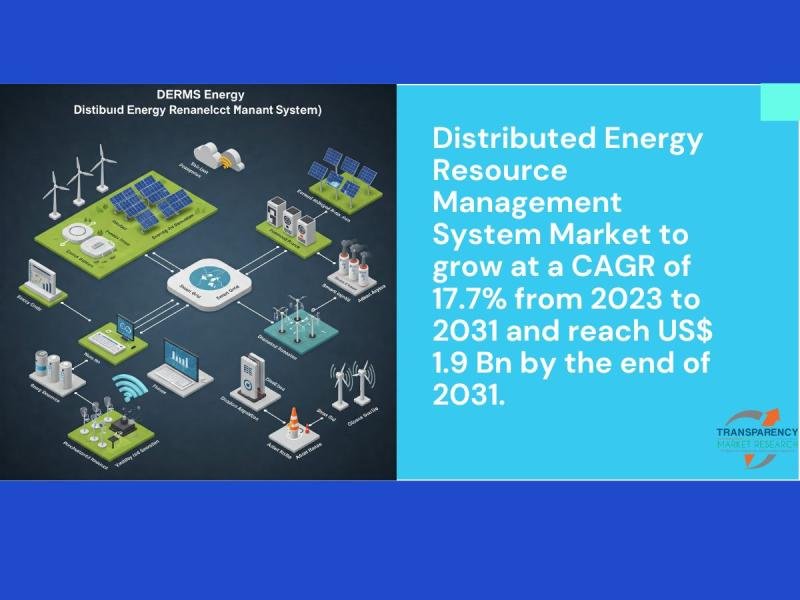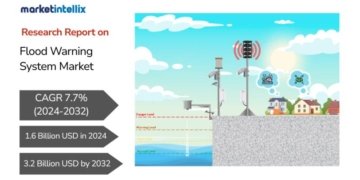The global distributed energy resource management system (DERMS) market is on the verge of a remarkable expansion, driven by the accelerating global shift toward cleaner, more sustainable energy solutions and the rapid proliferation of distributed energy resources (DERs). In 2022, the global DERMS industry was valued at USD440.4 million, and industry analysts project an impressive compound annual growth rate (CAGR) of 17.7% from 2023 to 2031. By the end of 2031, the market is expected to reach USD1.9 billion.
Access important conclusions and data points from our Report in this sample – https://www.transparencymarketresearch.com/sample/sample.php?flag=S&rep_id=42275
Market Overview
The increasing adoption of decentralized energy resources-such as rooftop solar photovoltaic (PV) systems, wind turbines, energy storage systems (ESS), electric vehicles (EVs), and demand response (DR) programs-is redefining the way energy is generated and managed. Distributed Energy Resource Management Systems (DERMS) serve as sophisticated software platforms that integrate and control these diverse energy sources. They empower utilities, grid operators, and consumers to optimize energy production, storage, and consumption, paving the way for improved grid stability and cost-effective energy management.
Advancements in artificial intelligence (AI) and machine learning are enhancing the capabilities of DERMS. These technologies are critical for forecasting energy production and consumption patterns, performing predictive analytics, and optimizing DER coordination and control. As a result, DERMS not only ensure maximum self-consumption of renewable energy but also enable consumers and businesses to reduce their energy costs significantly.
Market Drivers & Trends
Increased Adoption of Distributed Energy Resources (DERs):
One of the primary drivers for the DERMS market is the surge in DER installations globally. A notable example is the rise in rooftop solar PV systems, with estimates suggesting that by 2030, up to 100 million households may rely on these systems for their electricity needs. In addition, distributed storage solutions, including behind-the-meter storage, are gaining traction, allowing consumers to store excess energy for later use or to sell back to the grid.
Technological Advancements in AI and Machine Learning:
The incorporation of AI and machine learning into DERMS has revolutionized energy management by enabling predictive analytics and real-time operational adjustments. These advancements allow DERMS to forecast consumption patterns, optimize resource coordination, and efficiently integrate new energy sources, thereby bolstering grid reliability and operational efficiency.
Government Mandates and Incentives:
Supportive government policies play a crucial role in propelling the DERMS market forward. Initiatives such as Renewable Portfolio Standards (RPS), net metering policies, solar tax credits, and performance-based incentives (PBIs) have been instrumental in reducing market barriers. These policies not only drive the adoption of DERs but also provide a robust framework for sustainable energy development.
Participation in Electricity Markets:
The active integration of DERs in wholesale, ancillary service, and capacity markets is another significant trend. This participation enhances the financial viability of DER projects and promotes broader adoption, thus reinforcing the importance of advanced management systems like DERMS.
Key Players and Industry Leaders
The DERMS market features several established industry leaders who continue to innovate and expand their product offerings. Some of the key companies include:
General Electric
Siemens AG
Schneider Electric, Inc.
Enel X S.r.l.
Spirae, LLC
GridPoint, Inc.
Itron Inc.
Mitsubishi Electric Corporation
Hitachi, Ltd.
Oracle Corporation
EnergyHub
IBM Corporation
These industry leaders have demonstrated their commitment to advancing DERMS through continuous innovation, strategic partnerships, and robust financial backing. Detailed profiles of these companies, including their key product offerings, financial overviews, and strategic initiatives, are available in the comprehensive market report.
Recent Developments
Several noteworthy developments have further accelerated the DERMS market:
Oracle’s Advanced Distribution Management System: In November 2022, Oracle provided its Utilities Network Management System (NMS) to FirstEnergy, an Ohio-based energy provider. This cutting-edge system was deployed to effectively manage responses to power outages across FirstEnergy’s six-state electric system, demonstrating the practical applications of DERMS in enhancing grid reliability.
Itron’s Integration with Samsung’s Smart Platform: In September 2022, Itron announced the integration of its Industrial Internet of Things (IIoT) network solution with Samsung’s smart platform for utility-scale DERMS. This integration enables real-time energy consumption monitoring and provides a comprehensive view of energy usage, thereby optimizing energy distribution and consumption for consumers.
These advancements underscore the market’s dynamic nature and highlight how industry leaders are leveraging technology to overcome challenges and meet the evolving needs of energy consumers.
Market Challenges and Opportunities
Despite the promising growth, the DERMS market faces several challenges that need to be addressed:
Integration Complexity:
The diverse and decentralized nature of DERs poses significant challenges in integrating various energy sources into a cohesive management system. Ensuring interoperability among different DER technologies and legacy systems remains a critical concern for utilities and grid operators.
Cybersecurity Risks:
As DERMS increasingly rely on digital infrastructure and real-time data exchange, the risk of cyberattacks becomes more pronounced. Protecting these systems from cyber threats is imperative to maintain grid security and ensure reliable energy supply.
Regulatory and Policy Hurdles:
Although supportive policies exist in many regions, inconsistent regulatory frameworks across different jurisdictions can create uncertainties for market players. Harmonizing these regulations is essential for fostering market stability and growth.
Opportunities in the DERMS Market include:
Expansion in Emerging Markets:
Rapid urbanization and growing energy demand in regions such as Asia Pacific present substantial opportunities. With the implementation of advanced DERMS, these regions can enhance grid reliability and support sustainable energy development.
Technological Innovations:
Continuous advancements in AI, machine learning, and IoT technologies are set to further enhance DERMS capabilities, enabling more precise energy forecasting, better integration of renewable resources, and improved grid management.
Increased Consumer Participation:
As consumers become more aware of the benefits of renewable energy, there is a growing trend toward active participation in energy markets. DERMS can empower consumers to manage their energy consumption more effectively and even monetize excess energy.
Access detailed insights by visiting our full report – https://www.transparencymarketresearch.com/distributed-energy-resource-management-system-market.html
Future Outlook
Looking ahead, the future of the DERMS market is characterized by robust growth, innovation, and increased market penetration. The global push towards renewable energy and sustainable practices will continue to drive DERMS adoption. With the anticipated market value reaching US$1.9 billion by 2031, industry stakeholders are poised to benefit significantly from advancements in technology and supportive policy frameworks.
Industry experts predict that the integration of smart grid technologies, coupled with the deployment of advanced DERMS solutions, will revolutionize energy management practices. As the market matures, new business models and revenue streams will emerge, further stimulating innovation and competition among market players.
Market Segmentation
The DERMS market is segmented across various dimensions to provide a detailed analysis of its components, applications, and regional impact. Key segments include:
Component:
Software
Analytics
Management & Control
Virtual Power Plant (VPP)
Services
Application:
Solar
Energy Storage
Wind
EV Charging Stations
Others
End-user:
Commercial
Industrial
Residential
Regions Covered:
North America
Europe
Asia Pacific
Middle East & Africa
South America
These segments allow stakeholders to gain an in-depth understanding of market dynamics and identify the specific areas that offer the greatest potential for growth.
Frequently Asked Questions
Q: What is a Distributed Energy Resource Management System (DERMS)?
A: DERMS is a software platform that integrates and manages distributed energy resources such as solar PV systems, wind turbines, energy storage, and EV charging stations, enabling effective grid management and energy optimization.
Q: What factors are driving the growth of the DERMS market?
A: Key growth drivers include the increased adoption of DERs, technological advancements in AI and machine learning, supportive government mandates, and the growing participation of DERs in various electricity markets.
Q: Which regions are leading the DERMS market?
A: North America currently leads the market due to strong policy support and consumer awareness, while Asia Pacific is emerging as a significant growth region, driven by rapid urbanization and rising energy demand.
Q: Who are the key players in the DERMS market?
A: Major players include General Electric, Siemens AG, Schneider Electric, Enel X, Spirae, GridPoint, Itron, Mitsubishi Electric, Hitachi, Oracle, EnergyHub, and IBM Corporation, among others.
Q: What challenges does the DERMS market face?
A: Integration complexity, cybersecurity risks, and varying regulatory frameworks are among the main challenges. However, these are balanced by significant opportunities in technological innovations and market expansion in emerging regions.
Q: What is the future outlook for the DERMS market?
A: The market is expected to grow substantially, reaching a projected value of US$1.9 billion by 2031. Continuous technological advancements and supportive regulatory environments will drive this growth.
Buy this Premium Research Report to access comprehensive analysis – https://www.transparencymarketresearch.com/checkout.php?rep_id=42275<ype=S
Explore Latest Research Reports by Transparency Market Research:
Industrial Metaverse Market: https://www.transparencymarketresearch.com/industrial-metaverse-market.html
Web 3.0 Blockchain Market: https://www.transparencymarketresearch.com/web-3-0-blockchain-market.html
About Transparency Market Research
Transparency Market Research, a global market research company registered at Wilmington, Delaware, United States, provides custom research and consulting services. Our exclusive blend of quantitative forecasting and trends analysis provides forward-looking insights for thousands of decision makers. Our experienced team of Analysts, Researchers, and Consultants use proprietary data sources and various tools & techniques to gather and analyses information.
Our data repository is continuously updated and revised by a team of research experts, so that it always reflects the latest trends and information. With a broad research and analysis capability, Transparency Market Research employs rigorous primary and secondary research techniques in developing distinctive data sets and research material for business reports.
Contact:
Transparency Market Research Inc.
CORPORATE HEADQUARTER DOWNTOWN,
1000 N. West Street,
Suite 1200, Wilmington, Delaware 19801 USA
Tel: +1-518-618-1030
USA – Canada Toll Free: 866-552-3453
Website: https://www.transparencymarketresearch.com
Email: sales@transparencymarketresearch.com
This release was published on openPR.

















